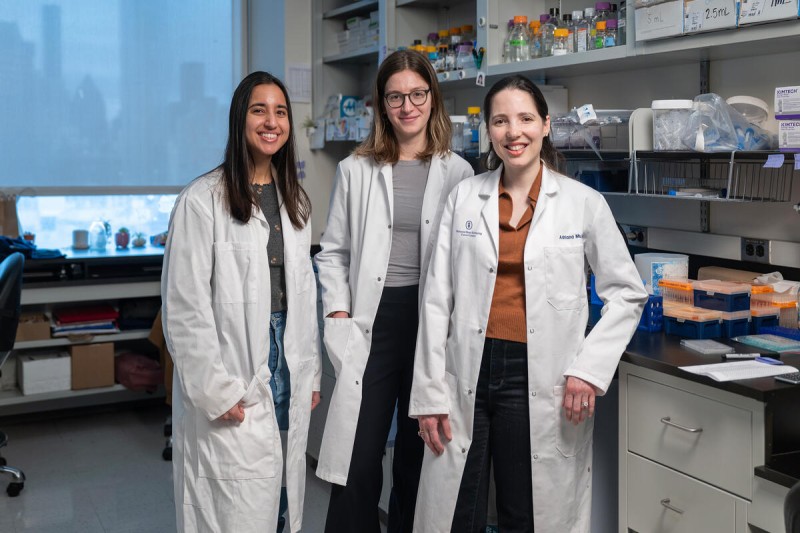
MSK is proud to announce that four Sloan Kettering Institute (SKI) researchers have been named 2025 Kravis WISE fellowship grant recipients.
This year’s winners are postdoctoral fellows Almudena Chaves-Pérez, PhD, and Adriana Mujal, PhD, and graduate students Hina Shah and Lydia Paraskevi Tsamouri. Read about these exceptional scientists and their research below.
Almudena Chaves-Pérez, PhD
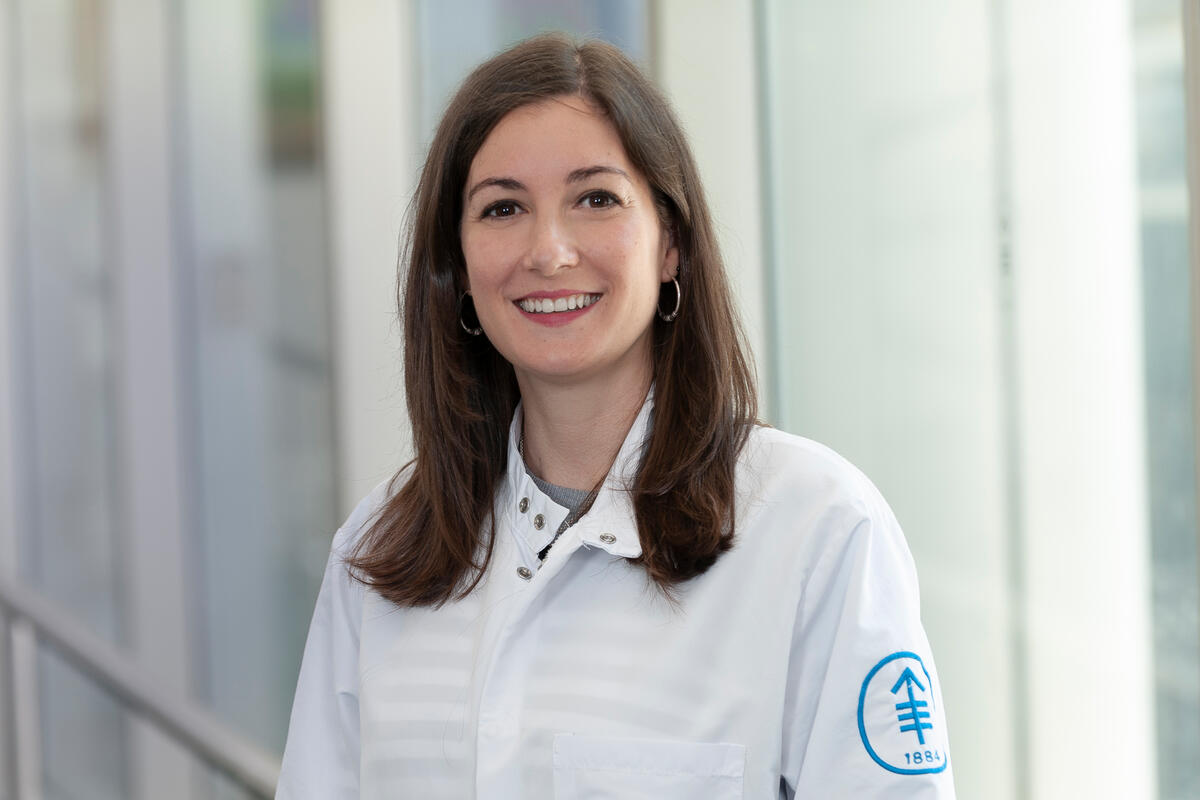
MSK postdoc Almudena Chaves-Pérez, PhD, has always been intrigued by things she can’t see.
“When I was younger, people would ask me, ‘What do you want to be when you grow up?’ And I would say, ‘I want to look through a microscope.’ ”
Her fascination with the unseen world began with her mother telling her about the immune system.
“My mom always wanted to become a nurse, but back then, as a woman, she couldn’t. Even so, she never lost her passion and kept learning,” Dr. Chaves-Pérez explains. “When I was 7 or 8, my mom took some courses in biology. I remember coming home from school, and she would tell me about what she had learned that day, and I was just so fascinated.”
She eventually decided that the best way to look through microscopes for a living was to become a scientist — so she did. She pursued an undergraduate degree in biotechnology, a master’s in biomedical sciences, and a PhD in molecular biosciences, all in Madrid, graduating cum laude.
In February 2020, Dr. Chaves-Pérez started her post-doctoral training in the lab of Scott Lowe, PhD, Chair of the Cancer Biology and Genetics Program at the Sloan Kettering Institute. Currently, she is transfixed by cells with stem cell-like properties, how they acquire specific cell fates, and all the intricate mechanisms of this process.
“Did you know we have a new intestine every seven days?” she asks me. “Your entire intestine is renewed every seven days by stem cells in the gut.”
“We know a lot about the basic facts of this turnover but not about how metabolism controls regeneration during homeostasis and after injury,” she adds.
Dr. Chaves-Pérez’s current research is focused on identifying the metabolites in the gut that trigger and guide this renewal, as well as what goes awry in ulcerative colitis and colon cancer.
She has learned, for example, that ulcers heal faster if a particular metabolite is given as a supplement to mice with ulcerative colitis. She and her colleagues, in partnership with the Tri-Institutional Therapeutics Discovery Institute (Tri-I TDI), are now trying to modify and encapsulate that compound into a pill.
More recently, she’s learned that there are several metabolites in the gut that can alter the aggressiveness of colon cancer cells and modulate the tumor microenvironment. Her hope is to eventually be able to improve the effectiveness of immunotherapies for colon cancer by shifting the metabolic environment in the gut.
“I’m extremely grateful to Marie-Josée Kravis and to MSK for standing behind this initiative,” she says. “Their efforts are really important in breaking down barriers and opening up opportunities for women in science. By supporting female scientists, they set an example and help empower us to push boundaries, all in the hope of making a real impact on society.”
Dr. Chaves-Pérez’s advice to young women in science?
“Don’t let anyone tell you what to do or that you can’t do it. You are capable enough — you can achieve whatever you set your mind to. If you are passionate about science and love what you are doing, then just go for it. Don’t let anything hold you back.”
Adriana Mujal, PhD
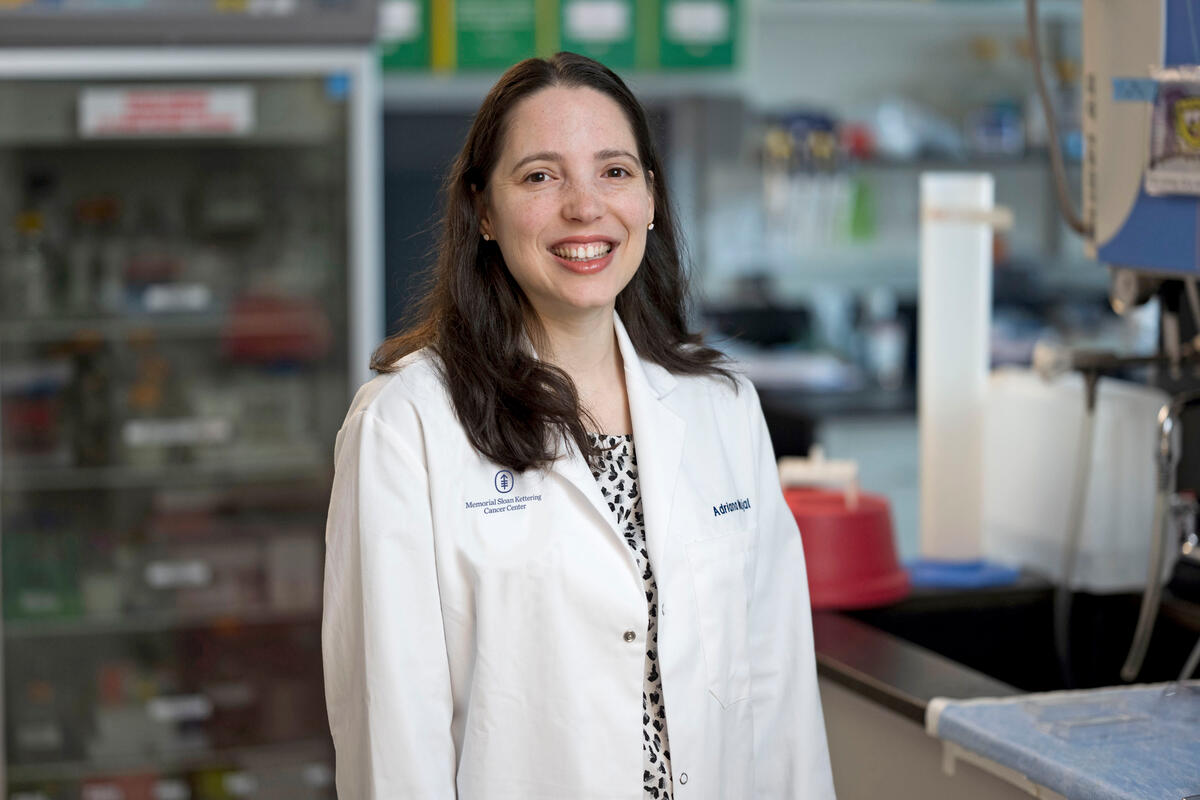
Many readers of science news have likely heard of T cells. These are the cells of our immune system that many current types of immunotherapy seek to empower to fight cancer.
MSK postdoc Adriana Mujal, PhD, spent several years studying T cells for her graduate work. But when it came time to pursue postdoctoral training, she decided to focus on another immune actor: the natural killer (NK) cell.
“To be honest, I had overlooked NK cells prior to my postdoc,” Dr. Mujal says, “so it felt like a good opportunity to dive into a new topic.”
She explains that NK cells are particularly interesting because they are complementary to T cells. They can perform some of the same killing functions, but they’re able to respond in some settings that T cells cannot. And that makes them attractive candidates for immunotherapy, she adds.
Her project is trying to understand what allows these NK cells to do their best work.
“I’m asking whether the responsiveness of these NK cells might differ depending on where in the body the NK cells are encountering their target, whether that’s a virus or a cancer cell,” she says.
Like many people who go into science, Dr. Mujal credits past and current mentors who have encouraged her.
“In high school, in California, I had a chemistry teacher who really sparked my love of science,” she says. “With their help, I ended up doing a high school summer program where I got to work in an immunology lab at Stanford. That was my introduction to research.”
Now, as a postdoctoral fellow in the lab of immunologist Joseph Sun, PhD, at the Sloan Kettering Institute, she is effusive about the support she gets from her current mentor.
“Joe’s awesome,” she says. “I feel like everyone loves him.”
Given her positive experience with mentoring, Dr. Mujal is eager to pay it forward.
“Having seen and experienced how impactful good mentorship can be, it makes me want to take these lessons and do the same for others.”
Dr. Mujal’s advice to young women in science?
“Seek out good mentors who are going to keep you excited about the science that you’re doing and who you can go to for advice along the way. If you can surround yourself with people who care about you, then that’s going to make a huge difference in your personal growth and scientific journey.”
Hina Shah
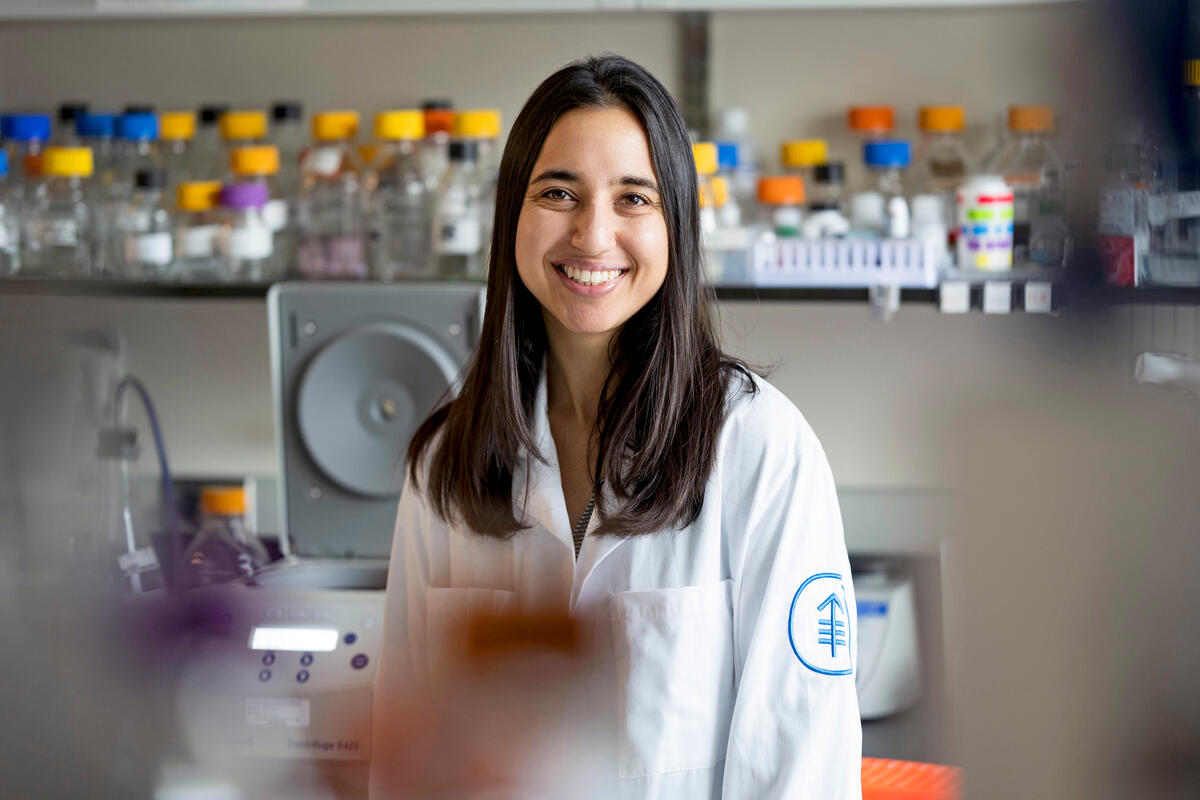
Fourth-year graduate student Hina Shah is fascinated by DNA repair — the process by which cells in our body identify and fix breaks in the genome. Fortunately, there are multiple ways that cells can fix those breaks, since incorrectly or unrepaired breaks in DNA can lead to cancer.
For her dissertation, which she is pursuing in the lab of molecular biologist Agnel Sfeir, PhD, at the Sloan Kettering Institute, Shah is looking at a potentially new kind of DNA repair pathway that hasn’t previously been observed in human cells.
“It’s called RNA-templated repair,” she says. “When you have a double-strand break in DNA, if there’s no complementary DNA sequence to copy and repair it, can the mRNA that’s already present be used as the template?”
She says that there’s some evidence the process happens in yeast cells, but her work would be the first time that scientists have seen it happening in human cells.
Shah came to this project from a background in genetics. “I liked genetics because a lot of science classes were just memorization and spitting out facts, but genetics was problem-solving.”
After college at Cornell University in Ithaca, New York, she spent a few years working with the genome-editing tool CRISPR at Mass General Hospital in Boston. There, she says, the focus of the work was on gene editing — making changes to DNA in order to intervene in diseases. But this new work is more mechanistic, more fundamental.
“My previous work was how can we manipulate systems and edit the genome. But here I’m asking: How are the cells doing it themselves?”
Shah acknowledges that pursuing science can be a difficult path. Many times, experiments don’t work. Imposter syndrome is real, she says. That’s one reason why she is so grateful to receive the Kravis WiSE graduate fellowship.
“Hearing that I got it was really exciting,” says Shah. “It was nice to see that other people are also excited about this work, that they think it’s interesting and has potential. It was a nice confidence booster.”
Ultimately, Shah wants to have a career in the biotech field, she says, “doing cool new CRISPR technologies or gene therapies.”
The Kravis WiSE fellowship will help her achieve that goal, she says.
Shah’s advice to young women in science?
“One of the things people really need to learn is not to take it personally when things don’t work. There is a steep learning curve. Even if someone gives a presentation and it sounds really polished, remember that they’re only showing you some of the work that went into it. They’re not showing you the failures.”
Lydia Paraskevi Tsamouri
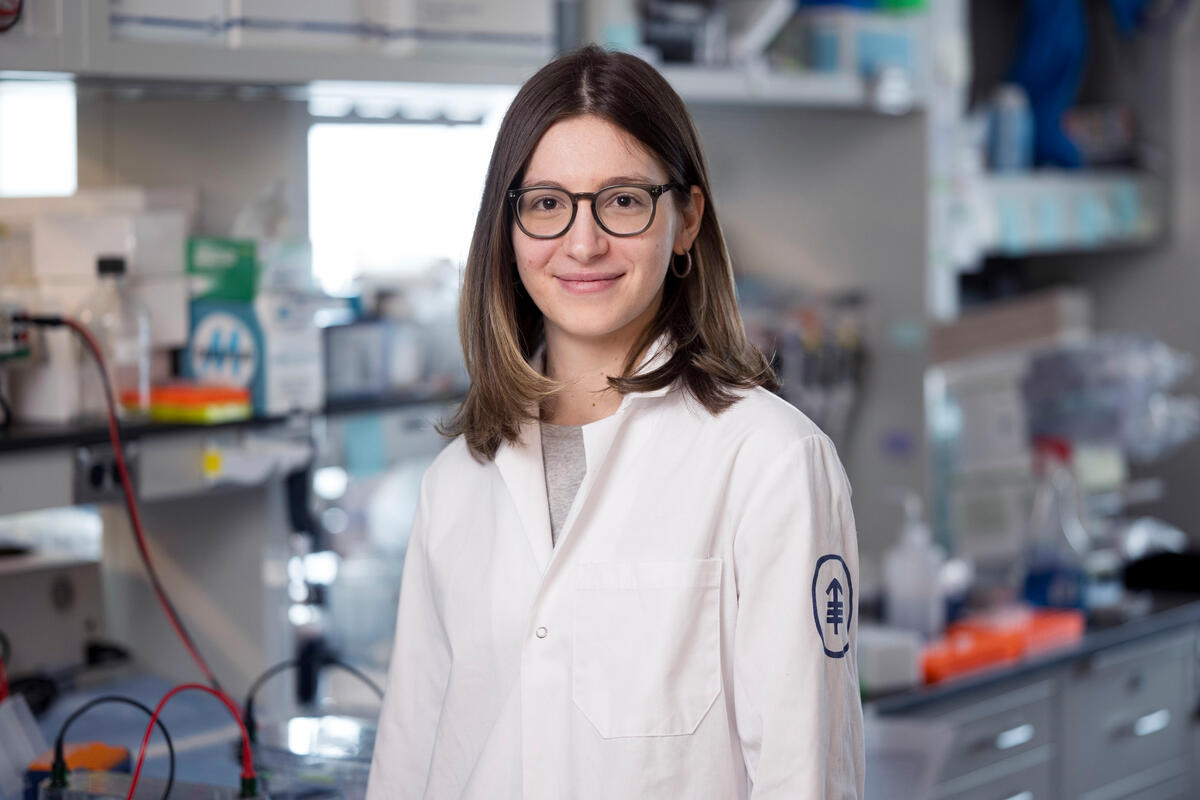
When Lydia Paraskevi Tsamouri was an undergraduate at the University of Surrey in England, she spent a year in New York City at Weil Cornell Graduate School and made a profound discovery about herself.
“I was in the lab doing science, and it was that moment that I thought, ‘Wow, I want to do this every day for the rest of my life,’ ” she recalls.
Now, as a fourth-year graduate student working in the lab of chemical biologist Dan Bachovchin, PhD, in the Sloan Kettering Institute, she is studying an enigmatic complex in cells called the NLRP1 inflammasome.
As the name suggests, the inflammasome triggers a fiery type of programmed cell death, called pyroptosis. The inflammasome is considered part of the innate immune system, responsible for protecting us against harmful invaders and cancer. But which pathogens or cancer signals the inflammasome responds to is still a mystery.
“The major question that we’re trying to ask is, ‘What is the evolutionary conserved signal that these inflammasomes have evolved to sense?’ Because despite these inflammasomes being in many cells of our body, the signal that activates them is unknown,” Tsamouri says.
So far, the only thing she and her colleagues know for sure triggers the inflammasome is a synthetic chemical called Val-boroPro. But since this chemical doesn’t exist in nature, it can’t be the natural trigger.
They know that Val-boroPro binds to and inhibits DPP9, a protease in the cell, and that DPP9 also binds to the inflammasome. So now their hypothesis is that DPP9 inhibition activates the inflammasome.
“Now the question becomes, ‘What inhibits DPP9?’ This is what I’m working on — to find the endogenous inhibitor of DPP9.”
To do that, she’s employing biochemical approaches and CRISPR gene-editing technology.
Tsamouri says she first got interested in science as an undergrad. She was a biochemistry major and had mentors who introduced her to the research process. “We would talk about science,” she says, “and I discovered I really loved the process of generating hypotheses and being able to test them.”
Some of the proudest moments in her career so far have come from small victories, she says, as when “a high-risk or technically challenging experiment works or when you find the answer to a question you set out to ask.”
Her goal is to one day run her own lab, a place “where we can talk about science every day and study interesting phenomena and hypothesize and then answer questions with experiments. That’s my dream.”
Tsamouri’s advice to young women in science?
“Do not be afraid to step out of your comfort zone and try new things. Even if a technique is not established in your lab, go ahead and try it.”